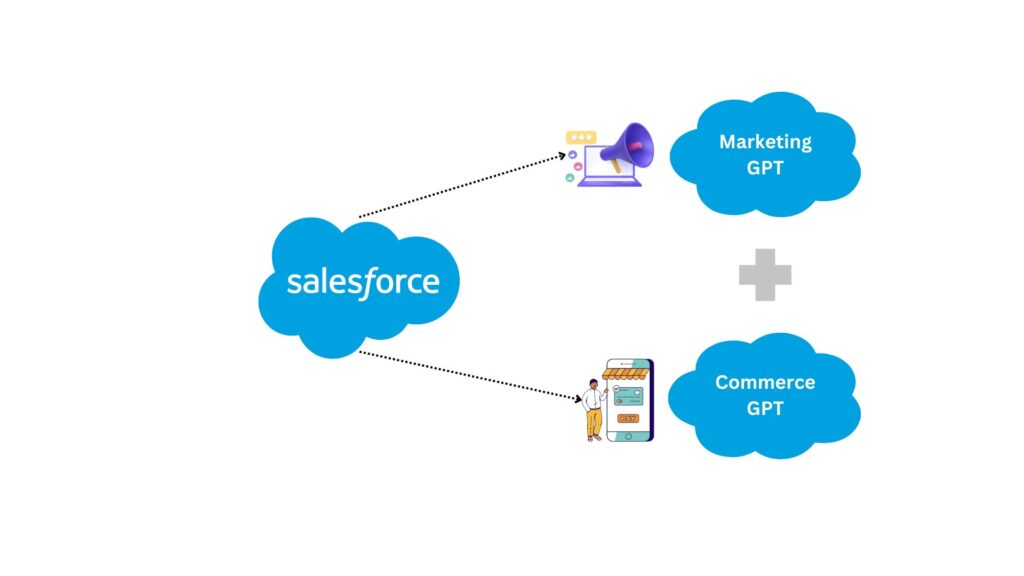Salesforce unveiled its most recent generative AI product offerings, which include the launch of Marketing GPT. The AI technology is made to aid marketers in creating personalized emails, more intelligent audience segments, and marketing journeys automatically.

Importance of Marketing GPT and Commerce GPT
Utilizing generative artificial intelligence (AI) is helping businesses become more efficient and productive. Its ability to have a revolutionary influence is clear from a survey that shows 60% of marketers believe generative AI will revolutionize their professional obligations and 71% believe it will free them up to focus on more important strategic activities. However, marketers’ top concern is with precision and excellence, with 63% saying that trustworthy customer data is a must for the effective application of generative AI.
With the help of artificial intelligence (AI) that generates initial information from the Data Cloud, Marketing GPT aims to create individualized, pertinent, and interesting experiences at every touchpoint.
Features of Marketing GPT
How can AI be adopted in a significant way for your company is a subject that is in many people’s thoughts. The application scenarios that Marketing GPT supports promote quick user acceptance. Here are some of the things that the Marketing GPT launch has in store.
- Creation of Segments – Utilizing AI-driven recommendations and natural language prompts, segment audiences and improve targeting.
- Creation of Email Content – Emails that are automatically generated and personalized can increase testing and engagement.
- Integrate several data sources automatically for a more thorough understanding of audience involvement.
- With quick identity resolution, segmentation, and engagement capabilities, customers’ identities are automatically resolved, and segments are refreshed to help assure accuracy.
- Using a particular business’s voice, style guidelines, and messaging, use Typeface’s productive AI content structure to produce context-dependent visual assets for a variety of channel campaigns.
- Collaboration in Marketing using Slack GPT – Users of GPT who marketers will communicate with it using natural language, which consists of conversational prompts that iteratively improve outcomes until the marketer is happy with it.
- This emphasizes the significance of always keeping the human ‘in the loop’ as the decision-maker during every encounter.
- Partnerships with Google Cloud Platform (for Data Cloud)
Commerce GPT
The company claims that the other creative AI-based product, called Commerce GPT, makes use of the Commerce Data-derived Cloud to assist businesses in providing customers with tailored offers and personalized purchasing experiences.
Features of Commerce GPT
- A second tool, dubbed Dynamic Product Descriptions, is also included in the new generative AI-based product, and automatically completes retailers’ missing catalogue data, according to Salesforce. It further stated that it could automatically create product descriptions that were customized for each buyer.
- The Commerce Concierge function, which can be utilized to enable customized dialogues with customers, is one of the other elements of Commerce GPT.
- With the use of automatically generated insights and suggestions based on unified actual-time information from the Data Cloud, Commerce GPT will allow businesses to provide tailored commerce experiences at each stage of the buyer’s journey. Brands will be able to utilize Commerce GPT and Data Cloud.
- Commerce GPT, you can automate marketing campaigns for increasing traffic and sales while boosting merchant efficiency. This innovative application enables firms to set objectives and targets and then offers practical information and proactive suggestions on how to achieve them.
- Commerce GPT provides recommendations for achieving desired results, from boosting margins to raising average order value (AOV), and is powered by Data Cloud, Einstein AI, and Flow.
- With Commerce Concierge, you can redefine loyalty and purchasing by driving personalized, interesting discussions, and assisting customers in easily finding products through user-generated interactions on channels ranging from messaging apps to online marketplaces.



